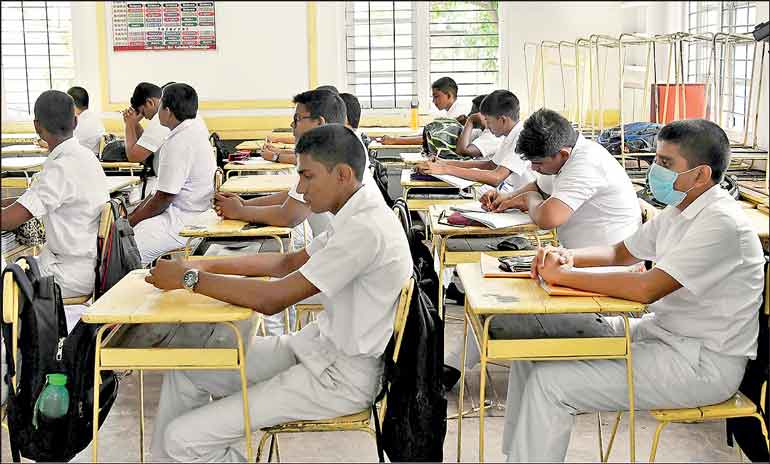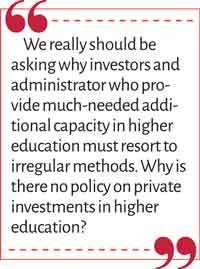Thursday Jan 15, 2026
Thursday Jan 15, 2026
Friday, 12 November 2021 00:00 - - {{hitsCtrl.values.hits}}

Let us get our priorities right. All new increases in education funding should be channelled to school education, with higher education institutions, both public and private, incentivised to charge fees for higher education with a substantial percent of places offered on as scholarships given disparities in income levels – Pic by Shehan Gunasekara
Vilifying private spending in higher education is a favourite past time of students and teachers in public universities and trade unions of Government employees such as the GMOA and teacher unions. Politicians happily join the fray, especially if there is nothing to show for their time in Government.
Politicians happily join the fray, especially if there is nothing to show for their time in Government.
Dr. Neville Fernando invested his own money to start SAITM, a private university that included a medical faculty, and he and the institution were hounded until SAITM closed down.
Latest is the damning of Mr. Paskaralingam, a former bureaucrat, for funding the Horizon Academy. I am not sure of about the financial issues surrounding his offshore fund, but the media reports are ridiculous. For example, they say, “[Pandora] Papers revealed Mr. Paskaralingam had for years funnelled funds into HCBT through a Singapore company owned by a trust registered in the British Virgin Islands.” Seriously? Should he have invested in rare art works and stored them in a warehouse in
Switzerland instead?
The vilification continues. This week Parliament was set to debate on the independence granted to SLITT, an institution which started as a limited by guarantee company under the control of the Government with a board consisting of various ex-officio persons. Government controls were gradually loosened with the institution now overseen by an independent board and the politicians and media are all too quick to name the present directors as villains. It is easy to condemn these institutions for irregularities, but are we asking the right question?
We really should be asking why investors and administrator who provide much-needed additional capacity in higher education must resort to irregular methods. Why is there no policy on private investments in higher education?
We also should be concerned about the impact on school education due to these vilifying frenzies. Since 1990, education spending has been stagnant at 10% of Government expenditure, barely keeping up with inflation. The student population in schools have stayed at around four million, but governments have been spreading the pie thinner to increase the intake to a fee-of-charge higher education at public universities, at the expense of public spending on school education.
Lack of policy leads to irregularities
If you ask the right question, you might find that in this country there is no way to bring private investment into the higher education sector without doing deals under the radar.
SAITM received unofficial recognition from Mahinda Rajapaksa-led UPFA Government from 2005-2015, but when in opposition the latter joined forces opposed to private universities. While there were public medical colleges that operated under sub-par conditions, SAITM was put under microscope by a Medical Council ideologically opposed to private universities. Making deals with the Government in power was the only way to protect one’s investment, it seemed.
power was the only way to protect one’s investment, it seemed.
In the case of Horizon Lanka, Mr. Paskaralingam chose to invest in an education institution, but for some reason he wished to remain anonymous. Nobody is talking about the contribution by Horizon Academy and affiliates. I made a cold call to the institution sometime back to see if they would like to pilot a holistic education program for primary education because Government schools were impossible to work with. I was impressed with facilities and the management and their emphasis on quality.
KDU is an example of a stealth policy to charge tuition from students attending a public institution. Here the mode of operation was to set it up under the Ministry of Defence and slowly bring in ‘day-scholars’ under the ‘protection’ of the Ministry. Why should our youth need the protection of the military to pay for an education?
In the absence of policy for public-private partnerships or private investments in higher education, we have investors adopting various means and ways to move forward. Meanwhile Bangladesh enacted a Private Universities Bill in 1992. Malaysia also provisions for private higher education and both countries are attracting students away from Sri Lanka.
The COPE committee is within its mandate to raise the issue of irregularities in funding or ownership issues of public enterprises. But who is there to speak for youth who are between a rock and hard place – bureaucratic public institutions that steal years from their youth or spending money for opportunities abroad? More importantly, who is there protect the erosion of spending on school education?
With stagnant education funding, less private higher education means less money for schools
While the Government makes proud claims of finding spaces for all who qualify at the GCE A/L, education funding has been stagnant at 10% of Government spending as far back as 1990. As the World Bank noted, in 2002, per capital spending on school education Sri Lanka is way below par and our ratio funding for School to funding for higher education is lopsided. (p. 38, https://www.researchgate.net/publication/283411678_Treasures_of_the_Education_System_in_Sri_Lanka_Restoring_Performance_Expanding_Opportunities_and_Enhancing_Prospects). Work on updating the statistics is ongoing.
Any increases for education must go to schools
Let us get our priorities right. All new increases in education funding should be channelled to school education, with higher education institutions, both public and private, incentivised to charge fees for higher education with a substantial percent of places offered on as scholarships given disparities in income levels.
The popular slogan for 6% of GDP for education in 2015-2020 period ended up with substantial increases for university teachers but nothing for schoolteachers. Let us put our priorities right this time and focus on compensation for teachers.